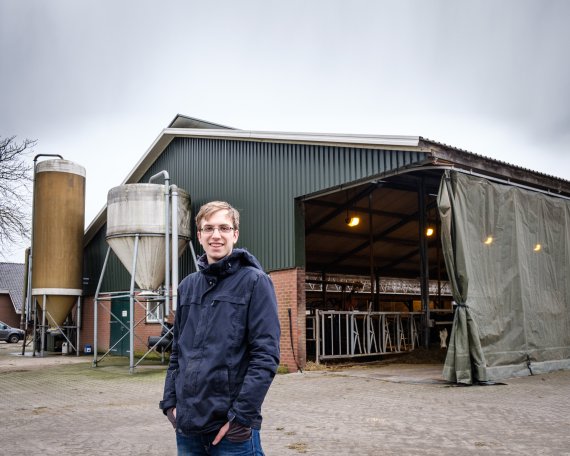text Albert Sikkema, photo Guy Ackermans
In the countryside around Lievelde in the Achterhoek region of the eastern Netherlands, lies the farm where Toon te Poele grew up. He is keep to explain how his father runs the dairy farm. Around the kitchen table are gathered five students who have accepted the invitation to take a look around. They are Wageningen students of Plant Sciences, Food Technology, Forest and Nature Management, and Nutrition and Health, and a Nijmegen student of Political Science.
Since 2008, Te Poele senior has had a free-stall barn in which they are free to move around, and with cubicles where they can lie down. They decide for themselves when they want to be milked by the milking robot. The robot accepts the cows for milking twice a day, and rewards them with feed pellets. In the spring of 2009, Te Poele opened the barn door, but not all the cows wanted to go outside. Since then they have stayed indoors, even in the summer.
Fluctuating milk yield
In the summer, the cows would rather be in the well-ventilated, cool barn than in the hot meadow, says Te Poele. ‘Don’t they want to move around?’ asks a student. They can do that in the barn too, says Te Poele, who is a student of Plant Sciences himself. They only run in the meadow when they come out for the first time in the spring. Normally they just graze, and they lie chewing the cud for at least eight hours a day. .
We can’t maintain hedgerows for the current milk price
But there are financial advantages to keeping cows in a barn too. Te Poele’s indoor cows get a precise mix of grass and maize silage, causing them to produce a little more milk year-round. And letting the cows out is time-consuming for the farmer – an investment that doesn’t pay off, says Te Poele. The FrieslandCampina premium for grazing cows is too low to cover it.
Cheap milk
This point keeps coming back: the consumer demands everything from the farmer – more animal welfare, less pollution, more grazing, more field birds – but goes on buying a litre of semi-skimmed milk at the supermarket for 75 cents. ‘Of that 75 cents, about 35 cents goes to the farmer, FrieslandCampina get something for processing the milk, and then the transporters and supermarket workers have to be paid as well.’
Yet farmers still go on investing, and they all have to make their own decisions about how to do so. Toon’s father chooses to hire someone to mow his grass. That costs money but saves on time and machinery. His cows are quite a bit smaller and sturdier than the familiar Holstein-Frisians, as we see on our guided tour. They are a cross-breed of the highly productive Holstein cow and the robust German Vleckvieh breed. They produce less milk but are healthier, so Te Poele also saves on veterinary bills.
Antibiotic use on the farm has gone down. Te Peole: ‘You want to minimize antibiotics use, because the milk of a cow that is being treated goes down the drain, so every sick cow costs you twice as much.’ Meanwhile the cows stand peacefully chewing the cud and gazing at their audience. A quiet barn with little lowing is a sign of wellbeing, says the farmer’s son.
Not nature conservationists
In 2000 the farm gave up some land to the State Forest Service Staatsbosbeheer for the creation of a nature reserve, in exchange for a larger housing plot. Many rare orchid species now grow in the large nature reserve. On the farm itself, there are no hedgerows or trees. ‘We are farmers, not nature conservationists,’ says Toon. ‘We can’t afford to maintain hedgerows for the current milk price. What is more, a hedgerow reduces the grass yield. We think consumers will have to pay the farmer if they want hedgerows and more trees.’
Nor is the farm participating in the special field bird programme aiming to boost lapwing and godwit populations. Delaying mowing the meadows is not an option. ‘We want to mow early in the year because that is when the nutritional value of the grass is highest.’
Cow passport
It is not the field birds but the cows that are the centre of attention on the farm. Te Poele senior keeps a close eye on their welfare, both in the barn and on his computer. Each cow has a passport containing records of its daily milk yield, the quality of the milk, dates of drying off and calving, and the cell count. The latter gives an indication of the number of bacteria in the milk. If it is too high, there is something wrong with the cow’s health.
Economic considerations are a constant factor. Last year the farm had to get rid of a number of cows due to government regulations for reducing phosphate production in the dairy industry. In such a situation you get rid of the least productive cows. In the corner of the barn lies a handicapped bull calf that cannot walk. It will be put to sleep soon because there is no place for it in this production system. You always have to bear in mind that the supermarket wants bargain prices like 75 cents a litre for milk, says Toon te Poele.
Eye-opener
So what do the Wageningen students think of what they have seen? ‘I have seen that the farm has the animals’ welfare at heart,’ says one of them over coffee at the end of the visit. Another says: ‘I thought cows should be outside in the meadow, but now I have seen that there are other ways of doing it.’ For a third, Te Poele’s robust cows were an eye-opener. What Te Poele wants to emphasize above all is the importance of a fair milk price. In his view, consumers and supermarkets have got to change.

